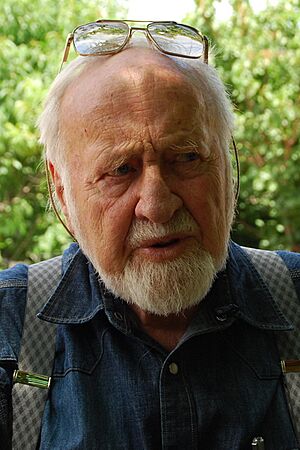Bill Mollison facts for kids
Quick facts for kids
Bill Mollison
|
|
|---|---|

Mollison in 2008
|
|
| Born | 4 May 1928 Stanley, Tasmania, Australia
|
| Died | 24 September 2016 (aged 88) Hobart, Tasmania, Australia
|
| Alma mater | University of Tasmania |
| Known for |
|
| Awards |
|
| Scientific career | |
| Fields | Biologist and environmentalist |
| Institutions |
|
Bruce Charles "Bill" Mollison (born May 4, 1928 – died September 24, 2016) was an Australian scientist, author, and teacher. He is best known for creating a special way of designing sustainable living systems called permaculture. In 1981, he won the Right Livelihood Award for his work in developing and sharing permaculture with the world.
Permaculture is a smart way to design our environment. It helps us grow food and live in a way that is good for the Earth forever. Bill Mollison worked with David Holmgren to create this idea. They wanted to find a way to farm that would last a long time. In 1978, they wrote a book called Permaculture One. This book introduced permaculture to many people. Mollison also invented the herb spiral, a clever garden design. It lets different herbs grow together in a small space.
Mollison started The Permaculture Institute in Tasmania. He also created a teaching system to train others in permaculture. This system, called the Permaculture Design Course (PDC), has taught thousands of people worldwide. They learned how to grow food and live sustainably using permaculture ideas.
Contents
Who Was Bill Mollison?
His Early Life and Work
Bill Mollison was born in 1928 in a small fishing village called Stanley in Australia. When he was 15, he left school to help his family with their bakery. Over the next 10 years, he had many different jobs. He worked as a shark fisherman, a sailor, a forester, and even a tractor driver. These experiences helped him learn a lot about nature.
In 1954, when he was 26, Mollison started working for the CSIRO. This is a big science organization in Australia. Later, he worked at the Tasmanian Museum. He also worked with the Inland Fisheries Commission, studying fish and water. In 1966, he went to the University of Tasmania. He studied bio-geography and later taught there. He stopped teaching in 1979.
How Permaculture Began
Bill Mollison's work with CSIRO helped him find his life's passion: permaculture. He once said that the idea came to him in 1959. He was watching animals in the Tasmanian rainforests. He was amazed by how much life there was and how everything was connected. He wrote in his diary, "I believe that we could build systems that would function as well as this one does."
By the late 1960s, he saw that modern farming methods were hurting the soil. They used too many non-renewable resources. They were also polluting land and water and reducing the number of different plants and animals. He wanted to find a better way.
Mollison felt that just protesting against these problems wasn't enough. He wanted to create something positive. He wanted a way for people to live without harming nature.
In 1974, he and David Holmgren came up with the idea of "permaculture." This word first meant "permanent agriculture." It was about creating a farming system with many different plants and animals. But Mollison soon realized it was more than just farming. It was about creating a "permanent culture." He understood that without healthy land and a good environment, no human culture could last.
Permaculture became a way to combine knowledge about sustainable living from all over the world. It included not just farming, but also how we build homes, how our communities work, and even how we manage money.
Mollison explained that permaculture helps people become self-reliant. This means being able to provide for your own needs. He said, "Self-reliance in food is meaningless unless people have access to land, information, and financial resources." So, permaculture also includes ideas for getting land, setting up businesses, and managing money in a sustainable way.
Spreading the Idea
In 1979, Bill Mollison helped start the first Permaculture Institute. Its goal was to teach people worldwide how to design sustainable systems. These systems included soil, water, plants, and even legal and money matters.
Mollison taught the very first Permaculture Design Course (PDC) in Tasmania in 1980. After this, people who completed the course started designing permaculture systems in their own communities. This helped the ideas of permaculture spread. By 2011, over 300,000 people had completed a PDC course. They were practicing and teaching permaculture all over the world.
Bill Mollison is often called the "father" of permaculture.
Bill Mollison's Films
In the late 1980s and early 1990s, Bill Mollison appeared in several videos. These videos helped make permaculture ideas popular.
- Permaculture: A 50-minute Australian film from 1989.
- In Grave Danger of Falling Food: Another 50-minute Australian film from 1989.
- The Global Gardener (1991): This was a series of films.
- Part 1 The Tropics
- Part 2 Drylands
- Part 3 Cool Climates
- Part 4 Urban Settings
See Also
- Peter Andrews
- David Holmgren
- Albert Bates
- Masanobu Fukuoka
- Sepp Holzer
- Albert Howard
- Brad Lancaster
- Geoff Lawton
- G. Nammalvar
- P. A. Yeomans
- Toby Hemenway

